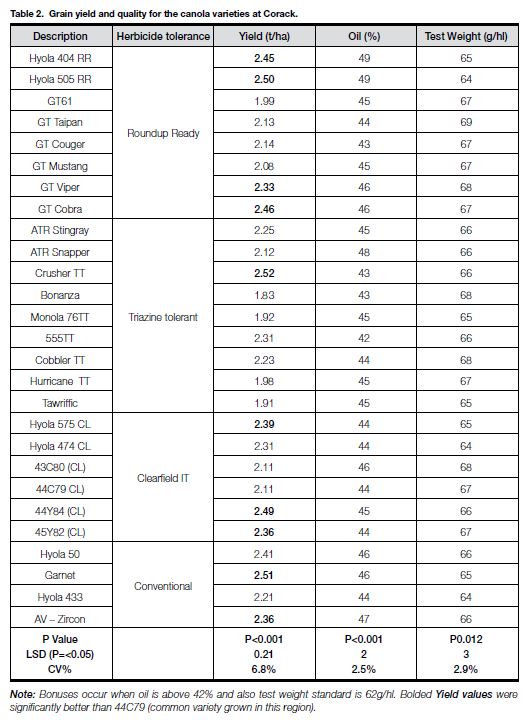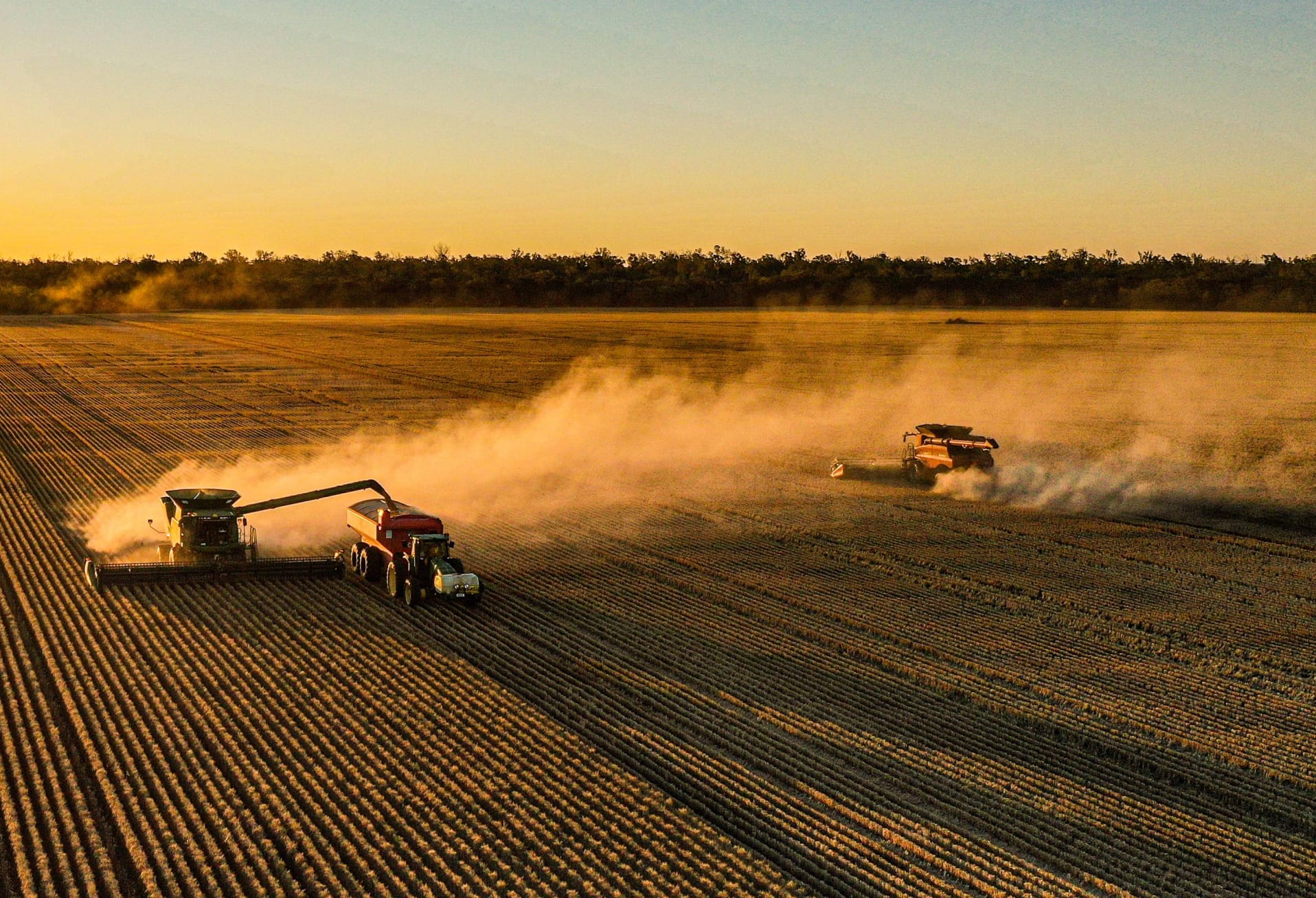BACKGROUND
After a wet summer with record rainfall of 481 mm (November 2010 – March 2011), canola was sown with confidence in 2011. The area sown to canola in Victoria tripled, reflecting this confidence resulting from a full profile of stored soil moisture and the fact that paddocks were in need of a break from a dominant cereal rotation. Canola provides various herbicide options for controlling problematic weeds (ryegrass, brome grass and radish).
BCG trials since 2008 have shown that canola is the most profitable break crop for the Mallee (BCG 2010 Season Research Results, pg 35). However, canola, because of its higher demand for nitrogen and the cost of seed and herbicides, can expose growers to increased financial risk. Growing canola after a pulse crop or on fallow (or with >50mm of stored soil moisture) will substantially reduce that risk.
TAKE HOME MESSAGES
- Crusher (TT), Garnet (conv), 44Y84 (IT) and Hyola 505 (RR) yielded significantly better than the site mean (2.20t/ha)
- oil (%) was above 42% in all varieties
- the best yielding of the triazine tolerant (TT) varieties were equal to the best of the other herbicide groups
- of the Clearfield tolerant (IT) varieties, hybrids (44Y84 and 45Y82) yielded 14% higher than conventional open pollinated varieties (44C79 and 43C80)
METHODS
Plots were direct-headed with a Kingaroy plot harvester and oil content was measured using a Foss Infratec NIR whole grain analyser. Yields were corrected to 6% moisture. To ensure all varieties came in together, all plots were desiccated prior to harvest. The trial was direct headed prior to rain with the result that minimal loss from shattering or lodging occurred.
RESULTS
With decile two rainfall during the growing season, conditions in 2011 should not have favoured canola production. The value of the soil moisture conserved over summer was yet another testimonial to the importance of controlling summer weeds. The profile showed 111mm/ha of plant available moisture. The site received 449mm from January to November. Of that, 124mm fell during the growing season (April 2011 to October 2011).
With a low soil nitrogen (N) status (total available N = 44kg N/ha) measured prior to sowing, there was a heavy reliance on applied N during the season. Three separate applications prior to rainfall events ensured that the canola was not N-stressed at any stage. Sulfur (14.5kg S/ha) was applied in June.
Even though the trial was sown in April, full emergence did not occur until the first week of June. At sowing, the topsoil was dry, with moisture at depth. The plots were intentionally sown slightly deeper (2-2.5cm) to chase some moisture and avoid mice damage. Little germination resulted; follow-up rainfall was required to stimulate germination. 3.5mm of rain was recorded on 9 May, but it was not until 16mm fell on 20 May that germination occurred. All plots emerged on 3 June. Between sowing and emergence, there was evidence of mouse damage, particularly in the neighboring cereal trials. The site was baited for mice serveral times with Mouse-off® to aid establishment.
Seeding rates were not varied to target a set plant density. The sowing rate was chosen based on the breeder’s recommendation of the ideal densities for that variety (e.g. hybrids perform equally as well at lower plant densities (15-25pl/m2) as at the higher (30-40/m2). In this trial, the established plant densities ranged from 25-70pl/m2. This variation in plant density was tested as a covariate with grain yield and was found to be not significant (P=0.684).
Weed burden at the site included barley grass, brome grass, Indian hedge mustard and, towards the end of the growing season, milk thistle. Late germination of mustard was persistent, particularly in the conventional plots. Roundup Ready plots were very clean, but required two applications of Roundup Ready herbicide at the 2 and 6 leaf stages. Verdict was applied over the entire trial to fit with district practice. Weed competition was low across all plots. No difference was observed in terms of weed control of the different systems.
Grain yields and oil content were above average. The trial mean yield was 2.20t/ha and oil was 44%. In the Triazine tolerant group, Crusher out-yielded 44C79, with a yield of 2.52t/ha. Of the four top-yielding varieties, one came from each herbicide group, three mid-maturity varieties and one early-maturing. Figure 1 illustrates the differences between varieties within a herbicide group (e.g. Triazine tolerant versus Clearfield). There was no difference in yield between the highest yielding varieties in each group.
INTERPRETATION
Several varieties yielded better than the two most commonly grown varieties 44C79 and Hurricane. Crusher (TT), Hyola 505 (RR), Garnet (Conv) and 44Y84 (IT) were the highest- yielding, each achieving 2.5t/ha. Given that each herbicide group includes an equally high- yielding variety, it appears the newer TT varieties do not have the yield penalties that were previously observed in TT varieties. ‘Partial’ gross margins show that the most profitable varieties were Crusher and Garnet, returning $861/ha and $858/ ha respectively.
It is important to consider maturity timing when choosing a variety. 43C80 and GT61 were the only varieties that recorded any shattering. Both of these varieties are early maturing which may have suited an earlier harvest date.
These results demonstrate that growers may choose canola from any herbicide group without incurring a yield penalty. With a canola price of about $490t, canola grown in 2011 was profitable. However, it must be remembered that these yields are not achievable every year. Canola can be seen as a ‘break crop’, providing benefits in herbicide rotation, controlling resistant weeds and operating as a disease break. The advantages are not always considered.
The 2011 NVT canola trial results for the Mallee are presented in Table 4. To compare the results between this trial and the local NVT yields, please refer to these tables. Please note that the same varieties were not grown at the two different sites.
COMMERCIAL PRACTICE
Varietal choice should be based on:
- weed spectrum
- the ability to control in-crop weeds with herbicide if necessary
- the most appropriate variety for the environment, ie. the time of maturity.
- proven performance (if there are a number of varieties that fit individual maturity and herbicide requirements)
REFERENCES
Browne C, Hunt J, Whitbread A, Hollaway G, Peoples M (2010) ‘Break Crops for the Mallee’, BCG 2010 Season Research Results, pg 35
ACKNOWLEDGEMENTS
This project was funded by BCG members






